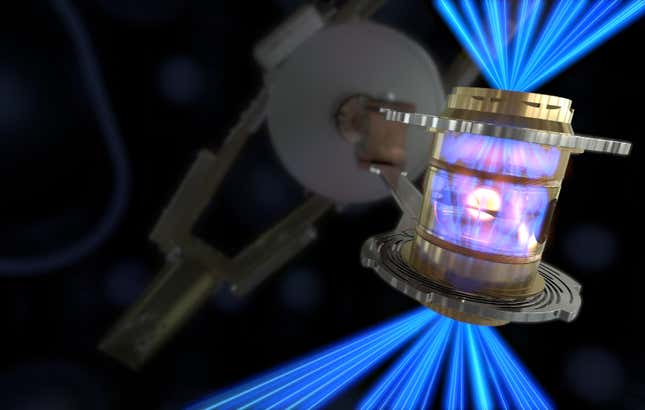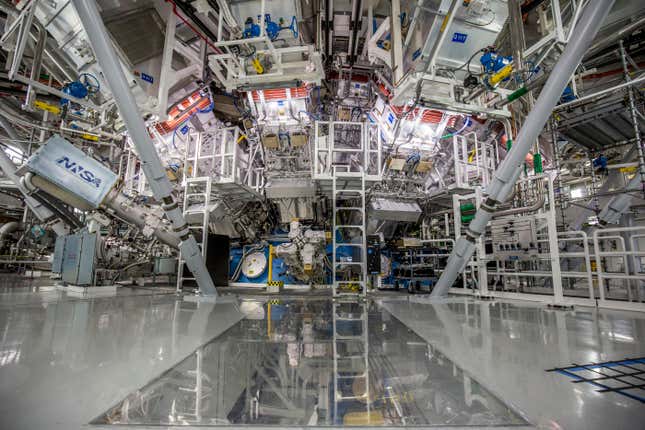
The U.S. Department of Energy announced Tuesday morning that scientists at Lawrence Livermore National Laboratory achieved net energy gain in a fusion reaction, a vaunted goal in humankind’s quest for a reliable, zero-carbon energy source.
Successful fusion reactions are nothing new, but the field has struggled with a big problem since its inception: Scientists have not been able to get more power out of a reaction than they had to put in. Now, that has happened.
The momentous result from the National Ignition Facility in California was initially reported on Sunday by the Financial Times; the news was confirmed today by government officials. In a Department of Energy press conference this morning, scientists and policy experts described the recent breakthrough.
Achieving ignition means science has “taken the first tentative steps towards a clean energy source that could revolutionize the world,” said Jill Hruby, the Under Secretary for Nuclear Security and National Nuclear Security Administration Administrator, during the news conference.
The Department of Energy confirmed that the facility achieved ignition just after 1 a.m. ET on December 5. Marvin Adams, the Deputy Administrator for Defense Programs at the National Nuclear Security Administration, explained the result bluntly: “about 2 megajoules in, about 3 megajoules out.”
Nuclear fusion is a thermonuclear reaction by which two light atomic nuclei fuse to form a single, heavier nucleus. The reaction gives off a huge amount of energy—Einstein’s E = mc2 in action. Fusion is the reaction that powers stars, and if humans could reliably and efficiently recreate the reaction on Earth, we could drastically cut back on, if not altogether abandon, dirty, carbon-based fuel sources. (Nuclear power plants rely on nuclear fission, a different process that produces less energy than fusion and results in radioactive waste, which fusion does not.)
Fusion can be done in different ways. The National Ignition Facility, the site of the recent breakthrough, does laser-based nuclear fusion. In the recent experiment, the teams at the laboratory focused 192 laser beams near a peppercorn-sized target in a diamond shell 100 times smoother than a mirror, delivering a remarkable amount of energy to the target about a billion times faster than you can blink. The extreme temperature (over 100 million degrees Fahrenheit) and pressure (more than 100 billion Earth atmospheres) induce nuclear fusion in the target.

“This had all happened before, a hundred times before,” Adams said. “But last week—for the first time—they designed this experiment so that the fusion fuel stayed hot enough, dense enough, and round enough, for long enough, that it ignited. And it produced more energies than the lasers had deposited.”
Laser-powered fusion is just one way to mimic the Sun’s intense physics. Scientists also can catalyze nuclear fusion in tokamaks and stellarators, doughnut- and cruller-shaped containers that generate magnetic fields to confine a plasma. Where laser-powered fusion is fleeting and occurs at high pressures and densities, magnetic fusion works at low pressures and densities for prolonged periods.
Martin Greenwald, a physicist at MIT’s Plasma Science and Fusion Center and a member of the MIT-CFS collaboration, told Gizmodo in an email that the result is “a mark of the maturity of the field and the validation of the underlying science.” But, he said, there are major barriers to making this science into a practical energy source on a larger scale.
“While a technical tour de force, the general approach, which this experiment takes, would require extraordinary advances in technology to have utility as an energy source,” Greenwald added. “To many of us, it seems unlikely that it would ever lead to a practical fusion power system. Thus we are pursuing magnetic confinement approaches.”
One of the largest efforts to demonstrate the technological feasibility of magnetic fusion in a tokamak is ITER, which on its completion will contain the largest superconducting magnet ever built and weigh a goliath 23,000 tons. ITER’s goal is to produce 10 times the amount of power than what’s necessary to produce the reaction.
In an email to Gizmodo, an ITER spokesperson heralded the NIF result as “a historic achievement for fusion energy.”
A longstanding trope of fusion research is that the clean energy revolution via fusion is always several decades away. Reporters at today’s briefing asked (reasonably, but perhaps in vain) about how the recent experimental result changes that timeline.
“Not six decades, I don’t think; not five decades, which is what we used to say,” responded Kim Budil, director of Lawrence Livermore National Laboratory. “I think it’s moving into the foreground, and with concerted effort and investment, a few decades of research on the underlying technologies could put us in the position to build a power plant.”
The more things seem to change, the more they stay the same.
Perhaps the most important letter in fusion is Q, which indicates the ratio of power used for a reaction compared to the power out. Prior to today, the JET tokamak held the record for energy output, with a Q of 0.67, set way back in the 1990s.
Though the National Ignition Facility’s laser-powered fusion is a very different experimental setup, it has now achieved a Q of 1.
But last week’s ignition has some big caveats: For one, a tremendous amount of energy was needed to power up those lasers—about 300 megajoules were needed “from the wall,” as Budil put it, to power the lasers to fire their 2 megajoules at the target, producing 3 megajoules of fusion power.
“The National Ignition Facility has been focused on creating this first step,” Budil said. “If we could not ignite capsules in a laboratory, you could not see a pathway to an inertial confinement fusion energy plant. So this was a necessary first step.”
“Now that we have a capsule that ignites, we need to figure out, can we make it simpler?” Budil added. “Can we begin to make this process easier and more repeatable? Can we begin to do it more than one time a day?”
The data from the December 5 ignition will need to be analyzed in much greater depth, which hopefully will inform other experimental teams about how to reach those manifold goals. In a technical panel held after the press conference, Michael Stadermann, the Target Fabrication Program Manager, said that the shell used in the December 5 ignition had flaws, meaning that the team expects the same results can be met or improved on in the near future.
“I have a special message to listeners who want to work on exciting, challenging, and important problems,” said Adams. “We’re hiring!”
More: The Marathon Race Toward Fusion Power Could Be Reaching a Sprint

